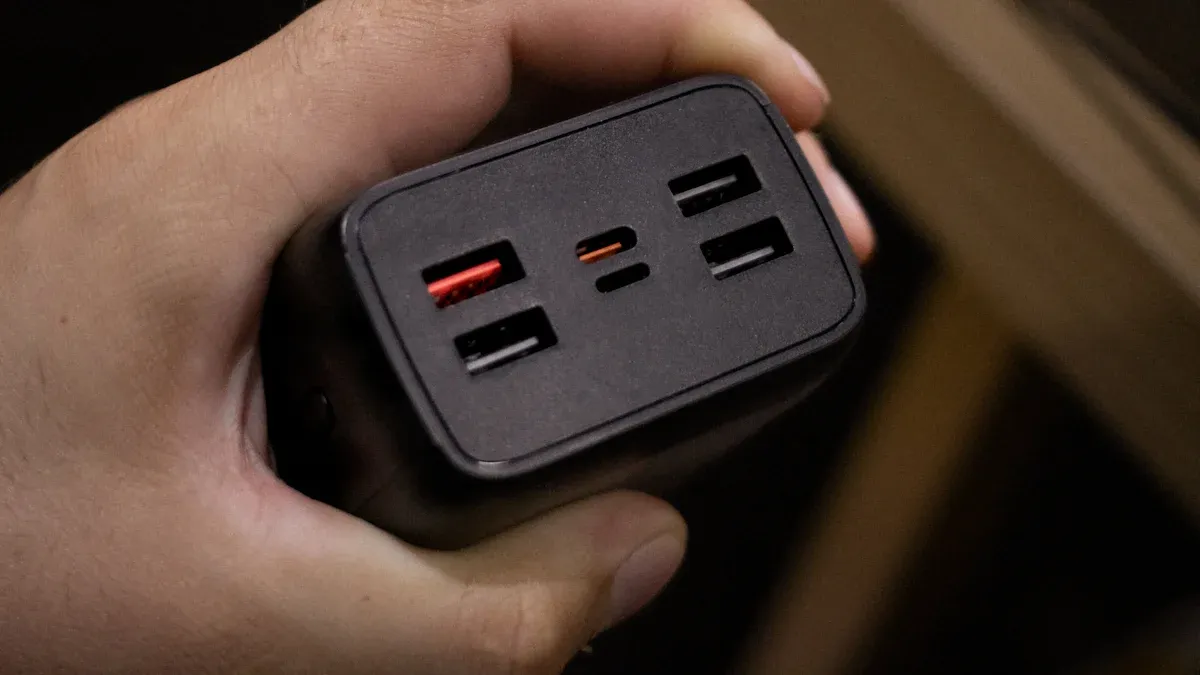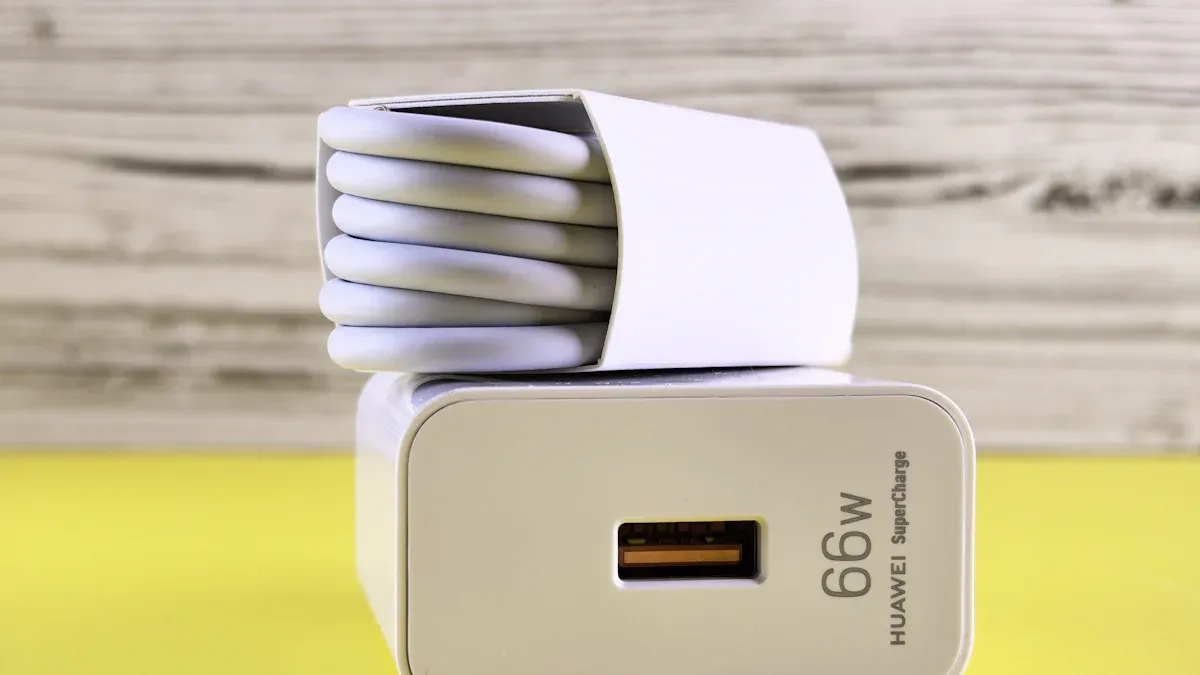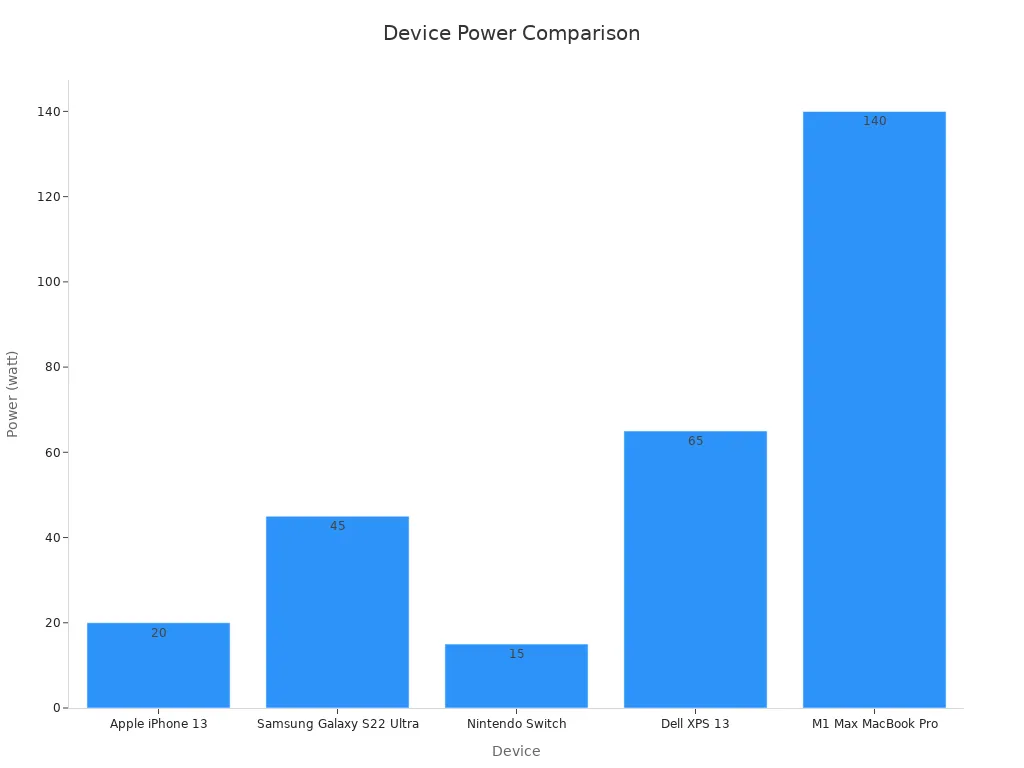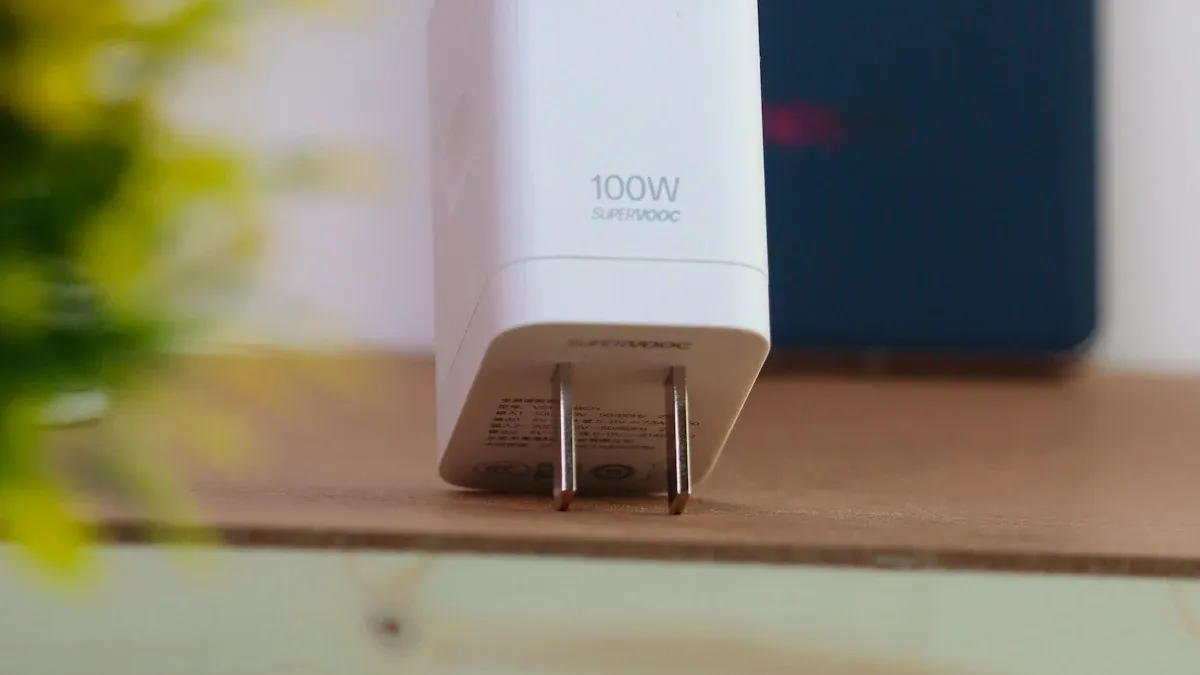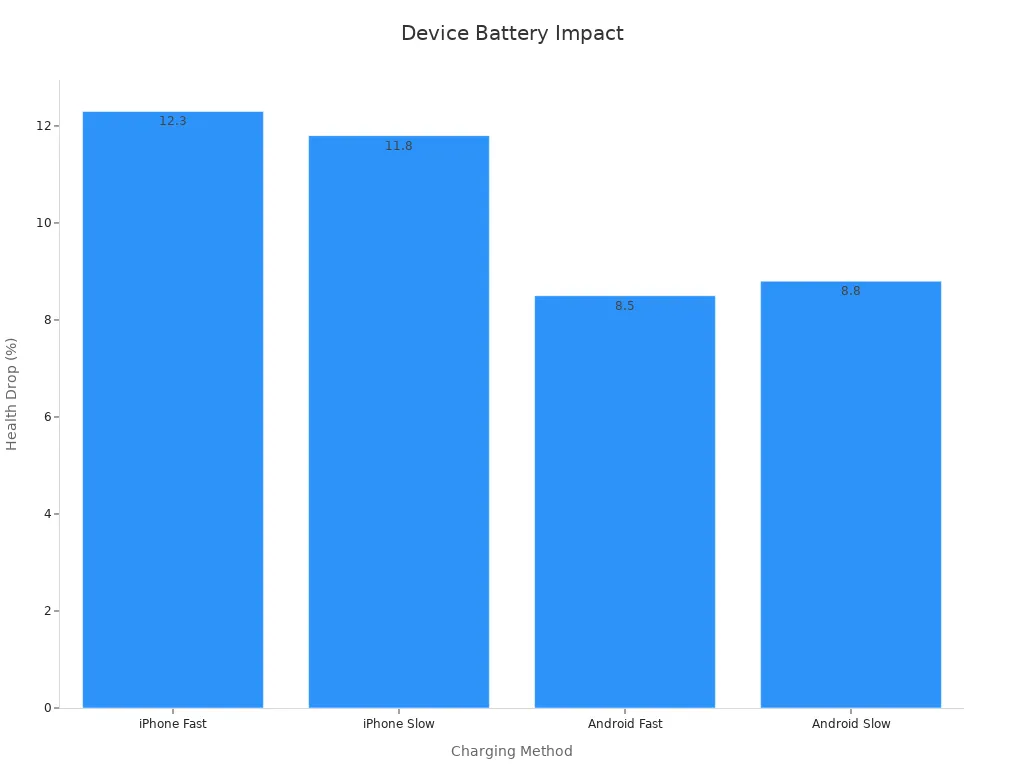Choosing the right usb fast charger protects your devices and improves their performance. A poor-quality charging block can overheat, damage your battery, or even cause safety hazards. Look for chargers with proper certifications and match their output to your device’s needs. Avoid counterfeit products to ensure safe and efficient charging every time.
Understanding USB Fast Charging
What is fast charging, and how does it work?
Fast charging allows your devices to recharge their batteries at much higher speeds than standard charging. This process works by increasing the voltage, current, or both, delivered to your device. Unlike traditional chargers, fast chargers communicate with your device to determine the optimal power level. This ensures safe and efficient charging.
Here’s how the process works:
1. Connection and Identification: Your device and charger exchange information about supported voltage and current levels.
2. Power Request and Response: The device requests the power it needs, and the charger adjusts its output accordingly.
3. Power Delivery and Monitoring: Once charging begins, both the charger and device monitor conditions. They adjust voltage and current as needed to maintain safety and efficiency.
For example, USB-C Power Delivery (USB-PD) dynamically adjusts power levels to match your device’s requirements. This technology can deliver up to 240 watts of power, far exceeding the 2.5 watts provided by older USB 2.0 connections. This ensures maximum charging speeds while protecting your device.
Common fast charging standards (USB Power Delivery, Quick Charge)
Several fast charging standards exist, but USB Power Delivery and Quick Charge are among the most popular. USB Power Delivery supports power levels up to 100 watts, with voltage options ranging from 5 to 20 volts. The latest revision, USB-PD 3.1, introduced Extended Power Range (EPR), which allows up to 240 watts of power at higher voltages like 28, 36, and 48 volts. This makes USB-PD ideal for charging laptops, tablets, and smartphones.
Quick Charge, developed by Qualcomm, is another widely used standard. It works with USB-PD and offers higher power delivery for compatible devices. Quick Charge 4.0, for instance, supports both USB-C and USB-PD, ensuring compatibility across a wide range of devices. Both standards prioritize safety by including features like temperature sensors and voltage regulators.
Fast charging technologies, including USB Power Delivery and Quick Charge, ensure your devices charge quickly without compromising safety. Whether you’re using USB-C cables or exploring MagSafe wireless charging, these standards provide reliable and efficient solutions.
Features of a Reliable USB Fast Charger
Wattage and power output explained
When choosing a USB fast charger, understanding wattage and power output is essential. Wattage refers to the total power a charger can deliver, while power output determines how efficiently it charges your devices. A higher wattage charger can support fast charging for multiple devices simultaneously. For instance, USB-C Power Delivery chargers can provide up to 240 watts, making them suitable for laptops, tablets, and smartphones.
Power output directly impacts device performance. In computing, performance per watt measures how much work a device can do for each watt of power consumed. This metric highlights the importance of selecting chargers with the right wattage to ensure energy efficiency. Similarly, in Power over Ethernet (PoE) systems, wattage and voltage determine the power delivered to devices. These factors ensure compatibility and efficiency, especially for devices requiring higher power levels.
Tip: Always check your device’s power requirements before selecting a charger. Using a charger with insufficient wattage can lead to slower charging, while excessive wattage may cause overheating.
Importance of multiple ports and power distribution
A reliable USB fast charger often includes multiple ports, allowing you to charge several devices at once. This feature is especially useful for families or individuals with multiple gadgets. However, the way power is distributed across these ports matters. High-quality chargers intelligently allocate power based on the connected devices’ needs. For example, if one device requires 18 watts and another needs 12 watts, the charger adjusts its output to meet these demands without overloading.
In public charging stations, power distribution plays a critical role. Studies show that 20% to 23% of chargers in such locations are faulty, often due to poor power management. This can lead to bottlenecks, especially in high-traffic areas. A charger with efficient power distribution ensures reliability and prevents such issues.
Note: Look for chargers with smart power allocation technology. This feature optimizes charging speeds and protects your devices from power surges.
Build quality and materials to look for
The build quality of a USB fast charger significantly affects its durability and safety. High-quality chargers use premium materials like durable plastics or metals that undergo rigorous stress tests. These tests simulate daily usage to ensure the charger can withstand wear and tear. For instance, aluminum or metal housings improve heat dissipation, reducing the risk of overheating.
Charging cables also play a role in overall performance. Braided jackets protect internal wires and offer better durability compared to standard plastic sheaths. Gold-plated connectors resist corrosion, ensuring a stable connection over time. Low-quality chargers, on the other hand, often lack these features and may pose safety risks like overheating or electrical overload.
Reminder: Always choose chargers from reputable brands with proper safety certifications. This ensures the materials meet industry standards and provide long-term reliability.
Safety Certifications for Fast Chargers
Key certifications to check (UL, CE, FCC)
When selecting a USB fast charger, checking for safety certifications is crucial. These certifications ensure the charger meets international standards for electrical safety and performance. Some of the most recognized certifications include UL, CE, and FCC. Each serves a specific purpose and applies to different regions.
| Certification | Region |
|---|---|
| CE | Europe |
| UKCA | UK |
| FCC | US |
| PSE | Japan |
| UL | Safety |
| CCC | China |
| IC | Canada |
| ACMA | Australia |
| TUV | Safety |
- UL (Underwriters Laboratories): UL certification focuses on product safety. It ensures chargers meet rigorous testing standards to prevent overheating, electrical shocks, and fire hazards.
- CE (Conformité Européenne): CE certification is mandatory for products sold in Europe. It guarantees compliance with health, safety, and environmental protection standards.
- FCC (Federal Communications Commission): FCC certification applies to chargers sold in the United States. It ensures the device does not interfere with other electronic equipment and complies with electromagnetic compatibility standards.
These certifications act as a seal of approval, giving you confidence that the charger is safe and reliable. Always look for these marks on the packaging or the charger itself.
How to verify a charger’s safety compliance
Verifying a charger’s safety compliance involves more than just checking for certification logos. You need to ensure the charger adheres to established guidelines and standards. Several organizations provide frameworks for testing and compliance.
Key organizations and their roles:
- American National Standards Institute (ANSI): Develops frameworks for creating and assessing standards.
- Underwriters Laboratories (UL): Conducts testing, inspection, and certification to ensure chargers meet safety requirements.
- CSA Group (CSA): Certifies products to meet North American standards.
- California Energy Commission (CEC): Enforces testing procedures for battery chargers to ensure energy efficiency.
Steps to verify compliance:
- Check for certifications like ANSI/UL1564 (industrial battery chargers) or ANSI/UL 2202 (AC to DC EV charging systems).
- Look for compliance with IEC 61851-1, which outlines general requirements for conductive charging systems.
- Confirm adherence to CAN/CSA-C22.2 NO. 107.2, which applies to household and commercial chargers.
Tip: Purchase chargers from reputable brands or official retailers. Counterfeit products often lack proper certifications and pose safety risks.
By following these steps, you can ensure the charger you choose meets the highest safety standards. This protects your devices and minimizes risks like overheating or electrical malfunctions.
Ensuring Compatibility with Your Devices
Matching charger output to device requirements
Choosing the right charger for your device ensures safe and efficient charging. Each device has specific power requirements, and using an incompatible charger can lead to slow charging or even damage. To match the charger output to your device, focus on three key factors: voltage, amperage, and wattage.
- Voltage (V): The charger’s voltage must match your device’s requirement. A mismatch can harm your device.
- Amperage (A): A charger with higher amperage is safe, but one with insufficient amperage will charge your device slowly.
- Wattage (W): Calculate wattage using the formula W = V × A. Ensure the charger’s wattage meets or exceeds your device’s needs.
Here’s a quick reference table to help you understand compatibility:
| Device | Max Power Requirement | Charger Compatibility |
|---|---|---|
| Apple iPhone 13 | 20 watts | Yes |
| Samsung Galaxy S22 Ultra | 45 watts | Yes |
| Nintendo Switch | 15 watts | Yes |
| Dell XPS 13 | 65 watts | Yes |
| M1 Max MacBook Pro | 140 watts | Yes |
Tip: Always check your device’s manual or specifications to confirm its power requirements before purchasing a charger.
Understanding USB-C, USB-A, and other port types
The type of USB port on your charger plays a significant role in compatibility and performance. USB-C and USB-A are the most common types, but they differ in size, power delivery, and functionality.
| Feature | USB-A | USB-C |
|---|---|---|
| Size and Shape | Larger, rectangular | Smaller, oval, reversible |
| Data Transfer Speeds | Up to 5Gbps (USB 3.0) | Up to 40Gbps (USB 3.2/Thunderbolt 3/4) |
| Power Delivery | 2.5W to 12W | Up to 100W |
| Reversibility | No | Yes |
| Versatility | Primarily for data transfer and charging | Handles data, charging, video/audio output |
USB-C chargers are more versatile and support higher power delivery, making them ideal for devices like the M1 Max MacBook Pro. USB-A chargers, while still common, are less efficient for fast charging modern devices.
Note: If your phone or laptop supports USB-C, opt for a USB-C charger to maximize charging speed and efficiency.
Understanding these differences helps you choose the right charger for your devices, ensuring optimal performance and safety.
Avoiding Counterfeit USB Fast Chargers
Identifying counterfeit or low-quality chargers
Counterfeit USB chargers often look identical to genuine ones, but they lack essential safety features. These chargers use poor-quality components, which can lead to overheating, electric shocks, or even fires. A UL investigation tested 400 counterfeit iPhone adapters and found a 99% failure rate. Shockingly, 12 of these adapters posed a risk of lethal electrocution. This highlights the dangers of using counterfeit products.
To identify counterfeit or low-quality chargers, follow these steps:
1. Compliance Testing: Check if the charger has passed in-lab tests at USB-IF.
2. Official Logos: Look for authentic USB logos on the packaging and cables.
3. E-Marker Chip: For cables supplying more than 5A, ensure they include an E-Marker chip, which indicates higher quality.
Tip: Avoid chargers with unusually low prices or those sold without proper packaging. These are often signs of counterfeit products.
Why reputable brands and retailers matter
Purchasing from a reputable manufacturer or retailer ensures you get a safe and reliable USB charger. Trusted brands like Anker, Duracell, and Energizer prioritize safety and quality. For example, Anker chargers include MultiProtect features to prevent overcharging and overheating. Duracell products offer overvoltage and short-circuit protection, while Energizer chargers come with safety timers and temperature monitors.
Reputable retailers also play a crucial role. They source products directly from manufacturers, reducing the risk of counterfeit items. When you buy from trusted sources, you protect your devices and ensure efficient charging. Investing in a high-quality charger may cost more upfront, but it saves you from potential hazards and device damage.
Reminder: Always choose chargers from well-known brands and authorized retailers. This simple step can safeguard your devices and provide peace of mind.
Risks of Using Unsafe Fast Chargers
Potential damage to devices and batteries
Using unsafe USB chargers can harm your devices and batteries. These chargers often fail to regulate power properly, leading to overcharging or overheating. Over time, this can degrade your battery’s long-term health and reduce its efficiency. A study revealed that over 50% of USB adapters tested did not meet safety standards, resulting in device damage. Additionally, less than 28% of USB cables passed flame tests, highlighting significant safety concerns.
Fast charging with substandard chargers can also impair battery performance. For example, data shows that fast charging methods cause a slight drop in battery health compared to slower methods. The table below illustrates this difference:
| Charging Method | Battery Health Drop (%) | Difference (%) |
|---|---|---|
| iPhone Fast | 12.3 | 0.5 |
| iPhone Slow | 11.8 | |
| Android Fast | 8.5 | 0.3 |
| Android Slow | 8.8 |
To protect your phone and other devices, always choose chargers that meet safety certifications and match your device’s power requirements.
Fire hazards and other safety concerns
Unsafe USB chargers pose serious fire risks. Reports show an increase in incidents involving smoke and fire due to higher power levels in charging devices. Physical damage to lithium batteries, combined with overcharging, can lead to fires. Batteries under stress may still function but become more prone to mechanical abuse, increasing the likelihood of combustion.
One tragic example involved Mr. Ian Johnson, who left three lithium polymer batteries charging on a carpet beside a sofa. This caused a fire that destroyed his house and resulted in his death. The table below provides details of this incident:
| Incident Description | Outcome | Date and Location |
|---|---|---|
| Mr. Ian Johnson left three lithium polymer batteries to charge on a carpet beside a sofa, leading to a fire that destroyed his house and resulted in his death. | House reduced to a charred state; Mr. Johnson died of extensive burns. | June 9, 2015, Parry Avenue, Singapore |
To avoid such dangers, always use chargers from reputable brands and follow safety guidelines. Avoid placing charging devices on flammable surfaces, and never leave them unattended for extended periods.
Choosing the right usb fast charger ensures your devices charge safely and efficiently. Focus on chargers with proper certifications, compatibility, and reliable brands. High-quality fast chargers adapt to evolving technology, offering better performance and safety. Prioritize quality over cost to protect your devices and enjoy the best fast chargers for your needs.
FAQ
What happens if I use a charger with a higher wattage than my device needs?
Your device will only draw the power it requires. A higher-wattage charger won’t harm your device if it meets safety standards.
Can I use a USB-C charger for devices with USB-A ports?
Yes, but you need a USB-C to USB-A adapter or cable. Ensure the charger supports the required power output for your device.
How can I tell if my charger supports fast charging?
Look for labels like “Quick Charge” or “USB-PD” on the charger. Check the wattage and voltage specifications to confirm compatibility with fast charging standards.

